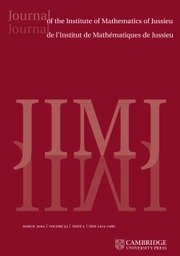For commutative rings A in which 2 is invertible, as well as for
![]() $A=\mathbb {Z}$
, [Reference Hornbostel and Park3, Proposition 2.3.5] is true. However, for some rings A in which 2 is not invertible, the result is not correct as stated. The reason is the description of the ideal T in the proof of loc. cit. is not correct in this case, and this might imply that the map
$A=\mathbb {Z}$
, [Reference Hornbostel and Park3, Proposition 2.3.5] is true. However, for some rings A in which 2 is not invertible, the result is not correct as stated. The reason is the description of the ideal T in the proof of loc. cit. is not correct in this case, and this might imply that the map
![]() $\alpha $
in loc. cit. is not an isomorphism. In more detail, let A be a commutative ring. Due to [Reference Dotto, Moi, Patchkoria and Reeh1, Corollary 5.2],
$\alpha $
in loc. cit. is not an isomorphism. In more detail, let A be a commutative ring. Due to [Reference Dotto, Moi, Patchkoria and Reeh1, Corollary 5.2],
![]() $\underline {\pi }_0\mathrm {THR}(A)$
is isomorphic to the Mackey functor
$\underline {\pi }_0\mathrm {THR}(A)$
is isomorphic to the Mackey functor

where
![]() $\mathrm {res}(x\otimes y)=xy$
for
$\mathrm {res}(x\otimes y)=xy$
for
![]() $x,y\in A$
,
$x,y\in A$
,
![]() $\mathrm {tran}(a)=2a\otimes 1$
for
$\mathrm {tran}(a)=2a\otimes 1$
for
![]() $a\in A$
, and
$a\in A$
, and
![]() $T_A$
is the subgroup generated by
$T_A$
is the subgroup generated by
![]() $x\otimes a^2 y-a^2 x\otimes y$
and
$x\otimes a^2 y-a^2 x\otimes y$
and
![]() $x\otimes 2ay-2ax\otimes y$
for
$x\otimes 2ay-2ax\otimes y$
for
![]() $a,x,y\in A$
. Let
$a,x,y\in A$
. Let
![]() $2A$
denote the ideal
$2A$
denote the ideal
![]() $(2)$
in A. We have the monomorphism
$(2)$
in A. We have the monomorphism
![]() $2A\to (A\otimes A)/T_A$
given by
$2A\to (A\otimes A)/T_A$
given by
![]() $2a\mapsto 2a\otimes 1$
for
$2a\mapsto 2a\otimes 1$
for
![]() $2a\in 2A$
. Its cokernel is isomorphic to
$2a\in 2A$
. Its cokernel is isomorphic to
![]() $(A/2\otimes A/2)/T_{A/2}$
, where
$(A/2\otimes A/2)/T_{A/2}$
, where
![]() $A/2:=A/2A$
. Observe that
$A/2:=A/2A$
. Observe that
![]() $T_{A/2}$
is the subgroup generated by
$T_{A/2}$
is the subgroup generated by
![]() $x\otimes a^2 y-a^2 x\otimes y$
for
$x\otimes a^2 y-a^2 x\otimes y$
for
![]() $a,x,y\in A/2$
. Hence, we have the short exact sequence
$a,x,y\in A/2$
. Hence, we have the short exact sequence
where
![]() $\varphi \colon A/2\to A/2$
denotes the Frobenius (i.e., the squaring map). In particular, [Reference Hornbostel and Park3, Proposition 2.3.5] holds if and only if
$\varphi \colon A/2\to A/2$
denotes the Frobenius (i.e., the squaring map). In particular, [Reference Hornbostel and Park3, Proposition 2.3.5] holds if and only if
![]() $\varphi $
is surjective.
$\varphi $
is surjective.
The only statement in [Reference Hornbostel and Park3] where this proposition is used is the following one in the proof of [Reference Hornbostel and Park3, Proposition 3.2.2], for which we now provide an alternative proof.
Proposition 1. Let
![]() $A\to B$
be an étale homomorphism of commutative rings. Then the induced morphism of Mackey functors
$A\to B$
be an étale homomorphism of commutative rings. Then the induced morphism of Mackey functors
is an isomorphism.
Proof. By [Reference Hornbostel and Park2, Lemma 5.1], the Mackey functor
![]() $\underline {\pi }_0\mathrm {THR}(\iota A)\square _{\iota A}\iota B$
is isomorphic to
$\underline {\pi }_0\mathrm {THR}(\iota A)\square _{\iota A}\iota B$
is isomorphic to

Using the above computations, we have the following commutative diagram where the vertical maps are induced by multiplication:

We only need to show that
![]() $\beta $
is an isomorphism. Since B is flat over A, the rows are short exact sequences, and
$\beta $
is an isomorphism. Since B is flat over A, the rows are short exact sequences, and
![]() $\alpha $
is an isomorphism. The induced square of commutative rings
$\alpha $
is an isomorphism. The induced square of commutative rings

is coCartesian by [4, Tag 0EBS] since
![]() $A/2\to B/2$
is étale. It follows that
$A/2\to B/2$
is étale. It follows that
![]() $\gamma $
is an isomorphism. Hence,
$\gamma $
is an isomorphism. Hence,
![]() $\beta $
is an isomorphism by the five lemma.
$\beta $
is an isomorphism by the five lemma.



